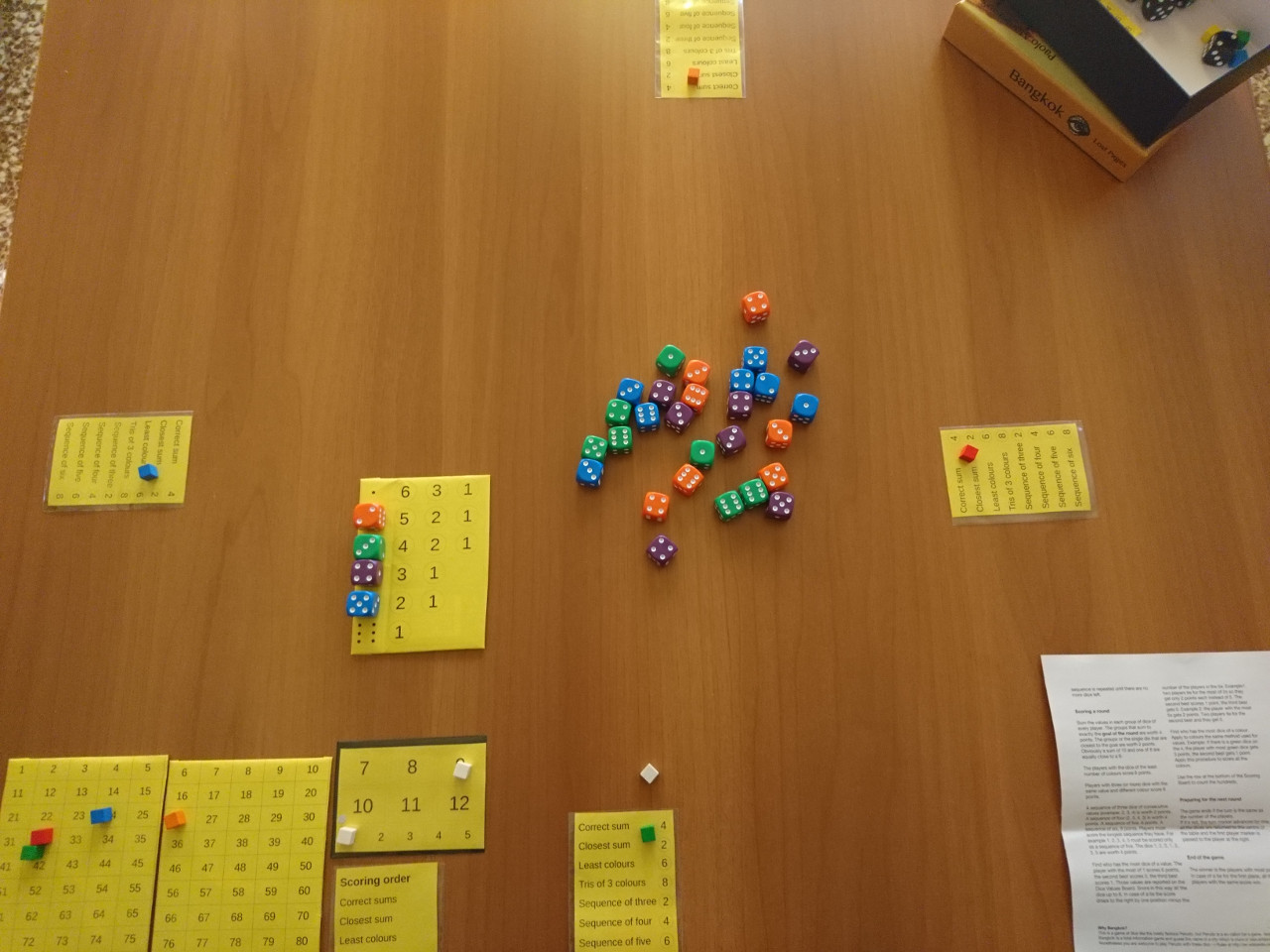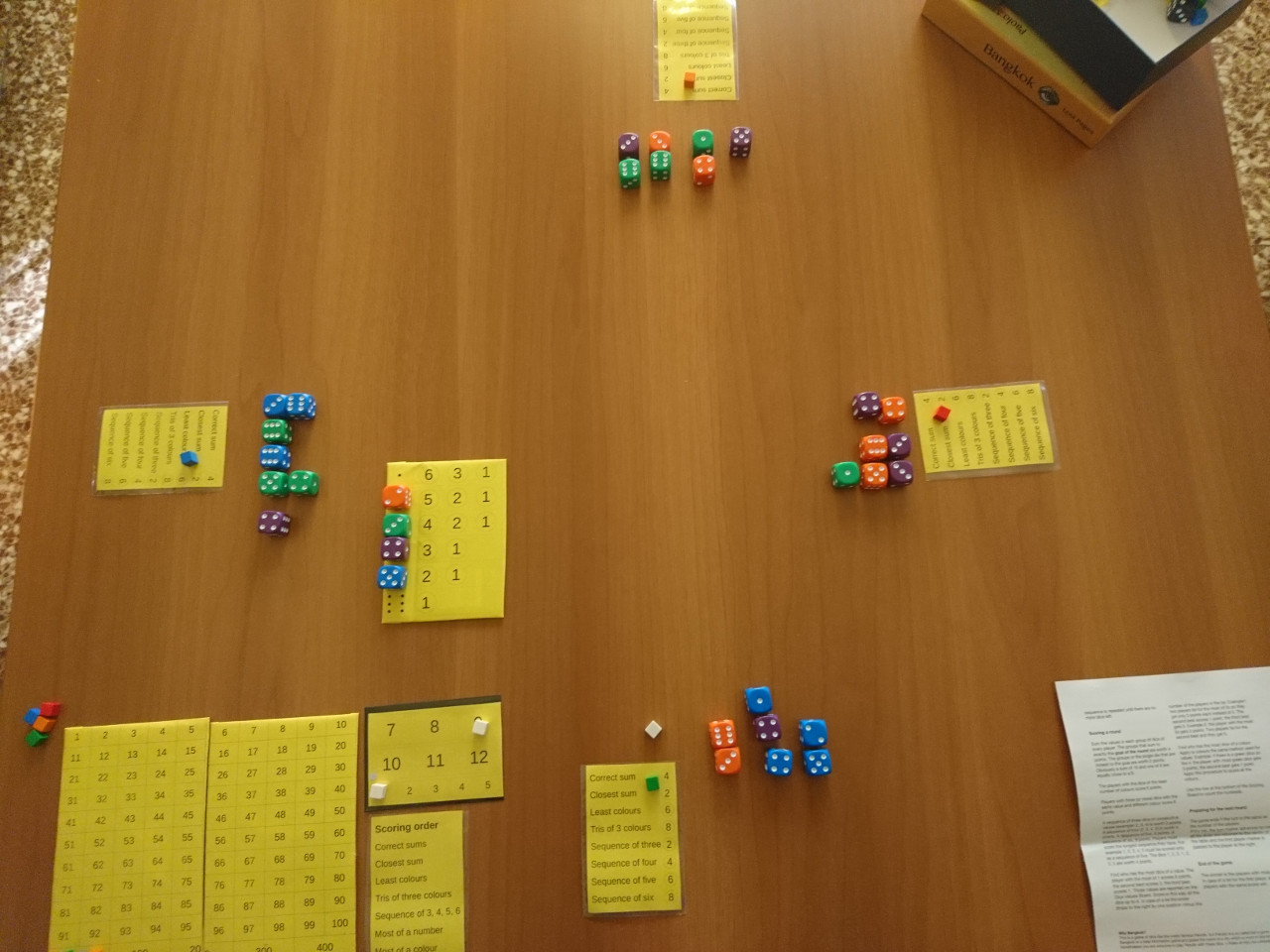Pick a die per turn and use it to make combinations based on sums, sequences and colours. Score the combinations and win by making more points than the other players.
Included in this repository:
- 1 Scoring Board in two pieces
- 1 Dice Values Board (the one with the dice symbols in a column on the left)
- 1 Goal Card (the one with the numbers 7 to 12 and 1 to 5)
- 1 Scoring Order Card
- 5 Scores Summary Cards
- This rulebook
Not included:
- 5 sets of eight dice, one different colour per set
- 6 sets of three colour markers, one different colour per set (little wooden cubes, glass pieces anything...)
The game is for 2 to 5 players. Each player chooses a colour and takes the three markers of that colour. They place one of their markers in front of them as a reminder. Assemble the Scoring Board. Each player puts a marker on the 0 in the line below the board and one marker outside the board, close to the 1 position. Chose as many sets of dice as the number of players. Put the others back into the bag. Choose one of the remaining marker sets. They'll be used as turn markers.
Pick the starting player at random. That player places one turn markers in front of him/her. Cast a die, sum six to it's value and put one of the turn markers on the corresponding number in the Goal Card. This number is the goal of the round. Put another marker at the 1 position on that board. This is the turn number. There are as many turns as the players.
Pick one die for every colour. Cast them and place them on the corresponding dice symbol on the Dice Values Board, starting from the lowest values. If there are more dice with the same value, place all the ones with unique values first. Now start again with the duplicate die with the lowest value and place it into the first empty space below the position it would have been placed to. If there are no empty places below, place it into the closest empty space above. Change the value of the die to match the one of it's position. Place all the dice following this procedure.
Cast all the other dice. They are seven per colour. Loosely group them in the centre of the table. Nobody must move them anymore.
The first player picks a die and puts it in front of him/her with the original value of the die facing upwards. The value of the die must not be changed.
The die can be kept separated from the other dice of the player or can be grouped by placing it in contact with another one or an existing group. The grouped dice will be counted together for the “correct sum”. The choice must be made immediately and can't be changed.
The player to the right plays next. The sequence is repeated until there are no more dice left.
Sum the values in each group of dice of every player.
- The groups that sum to exactly the goal of the round are worth 4 points.
- The groups or the single die that are closest to the goal are worth 2 points. A sum of 10 and one of 8 are equally close to a 9.
- The players with the dice of the least number of colours score 6 points.
- Players with three (or more) dice with the same value and different colour score 8 points.
- A sequence of three dice of consecutive values (example: 2, 3, 4) is worth 2 points.
- A sequence of four (2, 3, 4, 5) is worth 4 points.
- A sequence of five, 6 points.
- A sequence of six, 8 points.
Players must score the longest sequence they have. For example 1, 2, 3, 4, 5 must be scored only as a sequence of five. The dice 1, 2, 3, 1, 2, 3, 5 are worth 4 points.
-
Find who has the most dice of a value. The player with the most of 1 scores 6 points, the second best scores 3, the third best scores 1. Those values are reported on the Dice Values Board. Score in this way all the dice up to 6. In case of a tie the score shifts to the right by the number of the players in the tie minus one. Example1: two players tie for the most of 2s so they get only 2 points each instead of 5. The second best scores 1 point, the third best gets 0. Example 2: the player with the most 5s gets 2 points. Two players tie for the second best and they get 0.
-
Find who has the most dice of a colour. Apply to colours the same method used for values. Example: if there is a green dice on the 4, the player with most green dice gets 3 points, the second best gets 1 point. Apply this procedure to score all the colours.
Use the row at the bottom of the Scoring Board to count the hundreds.
The game ends if the turn is the same as the number of the players. If it's not, the turn marker advances by one, all the dices are returned to the centre of the table and the first player marker is passed to the player at the right.
The winner is the players with most points. In case of a tie for the first place, all the players with the same score win.
This is a game of dice like the overly famous Perudo, but Perudo is a so-called liar's game. Instead Bangkok is a total information game and guess the name of a city which is more or less antipodal to Peru? Nonetheless you are welcome to play Perudo with these dice :-) Rules at http://en.wikipedia.org/wiki/Dudo
© 2014 Paolo Montrasio – paolo@paolomontrasio.com This work is licensed under a Creative Commons Attribution-NonCommercial-ShareAlike 4.0 International License http://creativecommons.org/licenses/by-nc-sa/4.0/
Developed in 2014, made boxed sets for Christmas presents to friends in 2015 thanks to Lost Pages http://www.lostpages.co.uk/
-
Play with your friends and let me know how it goes :-)
-
Fixes to spelling and grammar are welcome. Preferably work on
README.md. If you want to also editrulebook.odgor have to fix something in the cards and score board, they are created with LibreOffice Writer and Draw. PDFs are exported from there. -
Open issues for bugs to the game mechanics or for any other idea.


